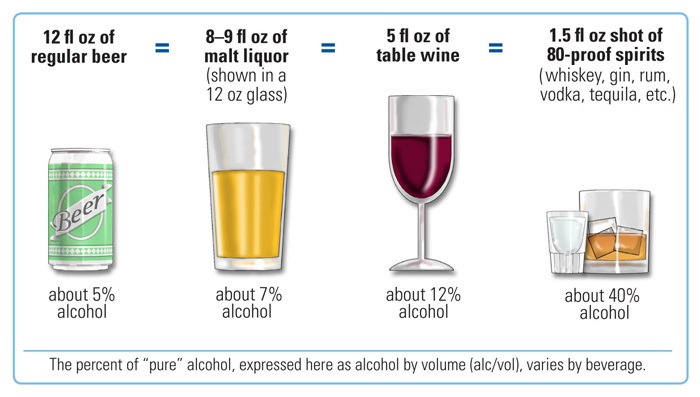|
Alcohol Abuse
Alcohol abuse encompasses a spectrum of alcohol-related substance abuse. This spectrum can range from being mild, moderate, or severe. This can look like consumption of more than 2 drinks per day on average for men, or more than 1 drink per day on average for women, to binge drinking. Alcohol abuse was a psychiatric diagnosis in the DSM-IV, but it has been merged with alcohol dependence in the DSM-5 into alcohol use disorder. Alcohol use disorder, also known as AUD, shares similar conditions that some people refer to as alcohol abuse, alcohol dependence, alcohol addiction, and the most used term, alcoholism. Globally, excessive alcohol consumption is the seventh leading risk factor for both death and the burden of disease and injury, representing 5.1% of the total global burden of disease and injury, measured in disability-adjusted life years (DALYs). After tobacco, alcohol accounts for a higher burden of disease than any other drug. Alcohol use is a major cause of preve ... [...More Info...] [...Related Items...] OR: [Wikipedia] [Google] [Baidu] |
The Drunkard's Progress
''The Drunkard's Progress: From the First Glass to the Grave'' is an 1846 lithograph by Nathaniel Currier. It is a nine-step on a stone arch depicting a man's journey through alcoholism. Through a series of Vignette (literature), vignettes it shows how a single drink starts an arc that ends in suicide. Below the structure, the protagonist's wife and child stand in tears. The lithograph is based on John Warner Barber's 1826 work ''The Drunkard's Progress, or The Direct Road to Poverty, Wretchedness, & Ruin''. Critical reception has been poor since the image was released, but it influenced other temperance-themed works. ''The Drunkard's Progress'' is used in high school American history classes to teach about the temperance movement. Background From the 1800s until the start of Prohibition in the United States, Prohibition in 1920, the Temperance movement in the United States, temperance movement was a major force in American life, advocating a ban on alcoholic beverages. The m ... [...More Info...] [...Related Items...] OR: [Wikipedia] [Google] [Baidu] |
Substance Abuse
Substance misuse, also known as drug misuse or, in older vernacular, substance abuse, is the use of a drug in amounts or by methods that are harmful to the individual or others. It is a form of substance-related disorder, differing definitions of drug misuse are used in public health, medical, and criminal justice contexts. In some cases, criminal or anti-social behavior occurs when some persons are under the influence of a drug, and may result in long-term personality changes in individuals which may also occur. In addition to possible physical, social, and psychological harm, the use of some drugs may also lead to criminal penalties, although these vary widely depending on the local jurisdiction.. Drugs most often associated with this term include alcohol, amphetamines, barbiturates, benzodiazepines, cannabis, cocaine, hallucinogens, methaqualone, and opioids. The exact cause of substance abuse is sometimes clear, but there are two predominant theories: either a gene ... [...More Info...] [...Related Items...] OR: [Wikipedia] [Google] [Baidu] |
Spider Angiomas
A spider angioma or spider naevus (plural: spider naevi), also nevus araneus, is a type of telangiectasis (swollen, spider-like blood vessels on the skin) found slightly beneath the skin's surface, often containing a central red spot and deep reddish extensions (see Blood color) which radiate outwards like a spider's web or a spider's legs. They are common and often benign, presenting in around 10–15% of healthy adults and young children. However, having more than three spider angiomas is likely to be abnormal and may be a sign of liver disease and/or hepatitis C (HCV virus); it also suggests the probability of esophageal varices. Signs and symptoms Spider angiomas are found only in the distribution of the superior vena cava, and are thus commonly found on the face, neck, upper part of the torso, and arms. Cause Spider angiomas form due to failure of the sphincteric muscle surrounding a cutaneous arteriole. The central red dot is the dilated arteriole and the red "spider le ... [...More Info...] [...Related Items...] OR: [Wikipedia] [Google] [Baidu] |
Cirrhosis
Cirrhosis, also known as liver cirrhosis or hepatic cirrhosis, chronic liver failure or chronic hepatic failure and end-stage liver disease, is a chronic condition of the liver in which the normal functioning tissue, or parenchyma, is replaced with scar tissue (fibrosis) and regenerative nodule (medicine), nodules as a result of chronic liver disease. Damage to the liver leads to repair of liver tissue and subsequent formation of scar tissue. Over time, scar tissue and nodules of regenerating hepatocytes can replace the parenchyma, causing increased resistance to blood flow in the liver's capillaries—the hepatic sinusoids—and consequently portal hypertension, as well as impairment in other aspects of liver function. The disease typically develops slowly over months or years. Stages include compensated cirrhosis and decompensated cirrhosis. Early symptoms may include Fatigue (medicine), tiredness, Asthenia, weakness, Anorexia (symptom), loss of appetite, weight loss, unexpla ... [...More Info...] [...Related Items...] OR: [Wikipedia] [Google] [Baidu] |
Central Nervous System Depression
Central nervous system depression (or CNS depression) is a nervous system disorder characterized by a severely impaired physiological state in which patients may exhibit decreased rate of breathing, decreased heart rate, and loss of consciousness; in extreme cases, CNS depression can possibly lead to coma or death. Causes Central nervous system depression is generally caused by the improper or excessive use of depressant drugs such as opioids, barbiturates, benzodiazepines, general anesthetics, anticonvulsants, and certain sleep medications. These drugs, although useful for treating severe cases of depression that may manifest as CNS depression, can easily be misused. The medications above depress the functions of the spinal cord and brain, both vital components of the central nervous system. In cases of misuse due to addiction, accidents, or unregulated dosage increases, individuals can very easily slip into unconscious coma states because neural activity drops below sa ... [...More Info...] [...Related Items...] OR: [Wikipedia] [Google] [Baidu] |
Fatigue (medical)
Fatigue is a state of tiredness (which is not sleepiness), exhaustion or loss of energy. It is a symptom of any of various diseases; it is not a disease in itself. Fatigue (in the medical sense) is sometimes associated with medical conditions including autoimmune disease, organ failure, chronic pain conditions, mood disorders, heart disease, infectious diseases, and post-infectious-disease states. However, fatigue is complex and in up to a third of primary care cases no medical or psychiatric diagnosis is found. Fatigue (in the general usage sense of normal tiredness) often follows prolonged physical or mental activity. Physical fatigue results from muscle fatigue brought about by intense physical activity. Mental fatigue results from prolonged periods of cognitive activity which impairs cognitive ability, can manifest as sleepiness, lethargy, or directed attention fatigue, and can also impair physical performance. Definition Fatigue in a medical context is used to ... [...More Info...] [...Related Items...] OR: [Wikipedia] [Google] [Baidu] |
United States Preventive Services Task Force
The United States Preventive Services Task Force (USPSTF) is "an independent panel of experts in primary care and prevention that systematically reviews the evidence of effectiveness and develops recommendations for clinical preventive services". The task force, a volunteer panel of primary care clinicians (including those from internal medicine, pediatrics, family medicine, obstetrics and gynecology, nursing, and psychology) with methodology experience including epidemiology, biostatistics, health services research, decision sciences, and health economics, is funded, staffed, and appointed by the U.S. Department of Health and Human Services' Agency for Healthcare Research and Quality. Intent The USPSTF evaluates scientific evidence to determine whether medical screenings, counseling, and preventive medications work for adults and children who have no symptoms. Methods The methods of evidence synthesis used by the Task Force have been described in detail. In 2007, their metho ... [...More Info...] [...Related Items...] OR: [Wikipedia] [Google] [Baidu] |
Alcoholism
Alcoholism is the continued drinking of alcohol despite it causing problems. Some definitions require evidence of dependence and withdrawal. Problematic use of alcohol has been mentioned in the earliest historical records. The World Health Organization (WHO) estimated there were 283 million people with alcohol use disorders worldwide . The term ''alcoholism'' was first coined in 1852, but ''alcoholism'' and ''alcoholic'' are considered stigmatizing and likely to discourage seeking treatment, so diagnostic terms such as ''alcohol use disorder'' and ''alcohol dependence'' are often used instead in a clinical context. Alcohol is addictive, and heavy long-term alcohol use results in many negative health and social consequences. It can damage all the organ systems, but especially affects the brain, heart, liver, pancreas, and immune system. Heavy alcohol usage can result in trouble sleeping, and severe cognitive issues like dementia, brain damage, or Wernicke–Kors ... [...More Info...] [...Related Items...] OR: [Wikipedia] [Google] [Baidu] |
Alcohol Use Disorder
Alcoholism is the continued drinking of alcohol despite it causing problems. Some definitions require evidence of dependence and withdrawal. Problematic use of alcohol has been mentioned in the earliest historical records. The World Health Organization (WHO) estimated there were 283 million people with alcohol use disorders worldwide . The term ''alcoholism'' was first coined in 1852, but ''alcoholism'' and ''alcoholic'' are considered stigmatizing and likely to discourage seeking treatment, so diagnostic terms such as ''alcohol use disorder'' and ''alcohol dependence'' are often used instead in a clinical context. Alcohol is addictive, and heavy long-term alcohol use results in many negative health and social consequences. It can damage all the organ systems, but especially affects the brain, heart, liver, pancreas, and immune system. Heavy alcohol usage can result in trouble sleeping, and severe cognitive issues like dementia, brain damage, or Wernicke–Korsakoff ... [...More Info...] [...Related Items...] OR: [Wikipedia] [Google] [Baidu] |
Standard Drink
A standard drink or (in the UK) unit of alcohol is a measure of alcohol consumption representing a fixed amount of pure alcohol. The notion is used in relation to recommendations about alcohol consumption and its relative risks to health. It helps to inform alcohol users. A hypothetical alcoholic beverage sized to one standard drink varies in volume depending on the alcohol concentration of the beverage (for example, a standard drink of spirits takes up much less space than a standard drink of beer), but it always contains the same amount of alcohol and therefore produces the same amount of intoxication. Many government health guidelines specify low to high risk amounts in units of grams of pure alcohol per day, week, or single occasion. These government guidelines often illustrate these amounts as standard drinks of various beverages, with their serving sizes indicated. Although used for the same purpose, the definition of a standard drink varies from country to country. L ... [...More Info...] [...Related Items...] OR: [Wikipedia] [Google] [Baidu] |
Liver Disease
Liver disease, or hepatic disease, is any of many diseases of the liver. If long-lasting it is termed chronic liver disease. Although the diseases differ in detail, liver diseases often have features in common. Liver diseases File:Ground glass hepatocytes high mag cropped 2.jpg, Ground glass hepatocytes File:Primary biliary cirrhosis intermed mag much cropping.jpg, Primary biliary cirrhosis File:Buddchiari2.PNG, Budd–Chiari syndrome File:Non-alcoholic_fatty_liver_disease1.jpg, Micrograph of non-alcoholic fatty liver disease There are more than a hundred different liver diseases. Some of the most common are: * Fascioliasis, a parasitic infection of liver caused by a liver fluke of the genus '' FascioIa'', mostly '' FascioIa hepatica''. * Hepatitis, inflammation of the liver, is caused by various viruses ( viral hepatitis) also by some liver toxins (e.g. alcoholic hepatitis), autoimmunity ( autoimmune hepatitis) or hereditary conditions. * Alcoholic liver disease is a h ... [...More Info...] [...Related Items...] OR: [Wikipedia] [Google] [Baidu] |
Tobacco
Tobacco is the common name of several plants in the genus '' Nicotiana'' of the family Solanaceae, and the general term for any product prepared from the cured leaves of these plants. More than 70 species of tobacco are known, but the chief commercial crop is ''N. tabacum''. The more potent variant ''N. rustica'' is also used in some countries. Dried tobacco leaves are mainly used for smoking in cigarettes and cigars, as well as pipes and shishas. They can also be consumed as snuff, chewing tobacco, dipping tobacco, and snus. Tobacco contains the highly addictive stimulant alkaloid nicotine as well as harmala alkaloids. Tobacco use is a cause or risk factor for many deadly diseases, especially those affecting the heart, liver, and lungs, as well as many cancers. In 2008, the World Health Organization named tobacco use as the world's single greatest preventable cause of death. Etymology The English word 'tobacco' originates from the Spanish word ''taba ... [...More Info...] [...Related Items...] OR: [Wikipedia] [Google] [Baidu] |





